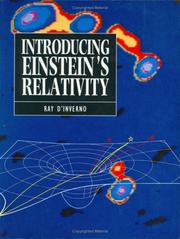| Listing 1 - 3 of 3 |
Sort by
|

ISBN: 0198596863 0198596537 9780198596868 Year: 2002 Volume: 27 Publisher: Oxford Clarendon
Abstract | Keywords | Export | Availability | Bookmark
 Loading...
Loading...Choose an application
- Reference Manager
- EndNote
- RefWorks (Direct export to RefWorks)
There is little doubt that Einstein's theory of relativity captures the imagination. It is unrivalled in forming the basis of the way we view the universe and the many surprises that the theory has in store -- the characteristics of black holes, the prospect of detecting gravitational waves, and the sheer scope and profundity of current cosmology excite all students of relativity. The aim of this textbook is to provide students with a sound mathematical introduction coupled to an understanding of the physical insights needed to explore the subject. The book follows Einstein in that it introduces the basic field equations by discussing the relativistic theory of gravitation from a physics point of view, and the structure on the resulting equations is discussed carefully before going on to their solution in simple settings. The book is designed with two objectives: to familiarize students with the basic ideas and equations of the theory, and to cover three main topics: black holes, gravitational waves, and cosmology. Throughout, the author has included numerous exercises (of varying degrees of difficulty) to illustrate and extend the ideas covered. As a result, this book will make an excellent first course for any student coming to the subject for the first time.
514.82 --- 530.12 --- Relativity (Physics) --- Black holes (Astronomy) --- -530.12 Relativity principle --- Relativity principle --- 514.82 Geometric questions and methods in relativity theory. Geometric questions of cosmology, of unified field theory etc. --- Geometric questions and methods in relativity theory. Geometric questions of cosmology, of unified field theory etc. --- Congresses --- -Gravitation --- -Geometric questions and methods in relativity theory. Geometric questions of cosmology, of unified field theory etc. --- -#dd Sabbe Camiel cfx --- Calculus of tensors --- Cosmology --- Gravitation --- Nonrelativistic quantum mechanics --- Space and time --- 530.12 Relativity principle --- Field theory (Physics) --- Matter --- Physics --- Antigravity --- Centrifugal force --- Astronomy --- Deism --- Metaphysics --- Absolute differential calculus --- Analysis, Tensor --- Calculus, Absolute differential --- Calculus, Tensor --- Tensor analysis --- Tensor calculus --- Geometry, Differential --- Geometry, Infinitesimal --- Vector analysis --- Spinor analysis --- Frozen stars --- Compact objects (Astronomy) --- Gravitational collapse --- Stars --- Geometric questions and methods in relativity theory. Geometric questions of cosmology, of unified field theory etc --- Properties --- #dd Sabbe Camiel cfx --- Theory of relativity. Unified field theory --- Einstein, Albert --- Black holes (Astronomy). --- Calculus of tensors. --- Cosmology. --- Gravitation. --- Relativity (Physics). --- Trous noirs (Astronomie) --- Calcul tensoriel --- Cosmologie --- Relativité (Physique) --- Relativité (physique) --- Trous noirs (astronomie) --- Study and teaching (Higher) --- Étude et enseignement (supérieur)
Book
ISBN: 9780198862031 0198862024 9780198862024 0198862032 Year: 2022 Publisher: New York, NY Oxford University Press
Abstract | Keywords | Export | Availability | Bookmark
 Loading...
Loading...Choose an application
- Reference Manager
- EndNote
- RefWorks (Direct export to RefWorks)
"The main aim of this textbook is to provide students with a sound mathematical introduction coupled to an understanding of the physical insights needed to explore the subject. Indeed, the book follows Einstein in that it introduces the theory very much from a physical point of view. After introducing the special theory of relativity, the basic field equations of gravitation are derived and discussed carefully as a prelude to first solving them in simple cases and then exploring the three main areas of application. This new edition contains a substantial extension content that considers new and updated developments in the field. Topics include coverage of the advancement of observational cosmology, the detection of gravitational waves from colliding black holes and neutron stars, and advancements in modern cosmology. Einstein's theory of relativity is undoubtedly one of the greatest achievements of the human mind. Yet, in this book, the author makes it possible for students with a wide range of abilities to deal confidently with the subject. Based on both authors' experience teaching the subject this is achieved by breaking down the main arguments into a series of simple logical steps. Full details are provided in the text and the numerous exercises while additional insight is provided through the numerous diagrams. As a result this book makes an excellent course for any reader coming to the subject for the first time while providing a thorough understanding for any student wanting to go on to study the subject in depth" --
Black holes (Astronomy) --- Gravitation --- Cosmology --- Calculus of tensors
Book
ISBN: 0511524633 Year: 1992 Publisher: Cambridge : Cambridge University Press,
Abstract | Keywords | Export | Availability | Bookmark
 Loading...
Loading...Choose an application
- Reference Manager
- EndNote
- RefWorks (Direct export to RefWorks)
This volume includes contributions by leading workers in the field given at the workshop on Numerical Relativity held in Southampton in December 1991. Numerical Relativity, or the numerical solution of astrophysical problems using powerful computers to solve Einstein's equations, has grown rapidly over the last 15 years. It is now an important route to understanding the structure of the Universe, and is the only route currently available for approaching certain important astrophysical scenarios. The Southampton meeting was notable for the first full report of the new 2+2 approach and the related null or characteristic approaches, as well as for updates on the established 3+1 approach, including both Newtonian and fully relativistic codes. The contributions range from theoretical (formalisms, existence theorems) to the computational (moving grids, multiquadrics and spectral methods).
Relativistic astrophysics --- Einstein field equations --- Numerical calculations --- Technique --- Data processing
| Listing 1 - 3 of 3 |
Sort by
|

 Search
Search Feedback
Feedback About
About Help
Help News
News